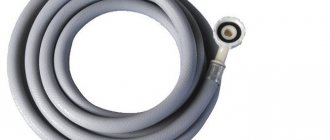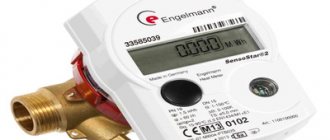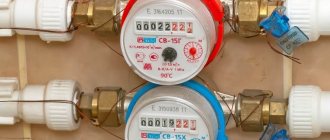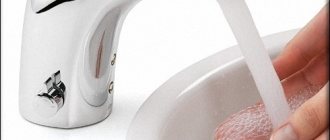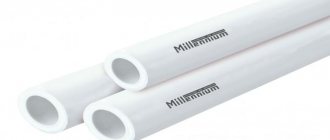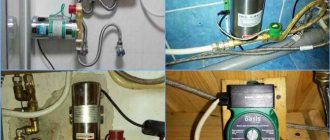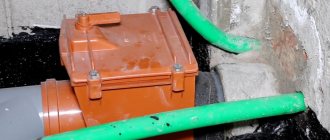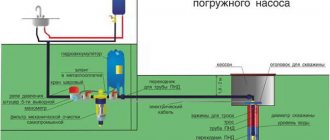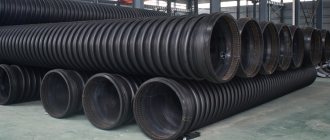The house should always be cozy, and one of the factors that ensures comfort is hot water supply.
DHW - hot water supply systems are designed to heat cold water coming from cold water supply pipes (CWS). Today, depending on the method of heating, there are two hot water supply systems:
- system with flow-through heater;
- storage system.
Connection diagrams
What schemes can be used:
Instantaneous water heater
A scheme using a flow-through heater involves heating water in a specially designated tank or device at a time when water passes through it under pressure.
There are a huge variety of ways to provide flow-through heating by using:
- geyser;
- electric flow heater;
- water supply systems with heating system;
- double-circuit boiler.
In each case, one principle is involved - instant heating of water from heating elements. To make the water hot enough, it is necessary to install very powerful electrical devices or consume a large amount of gas, otherwise the water at the outlet will not reach an acceptable temperature.
The same applies to the number of water distribution points; for example, taking a shower and washing dishes at the same time will be difficult, since not every device can heat a large amount of water at once.
Storage heater
The second method is to install a water heating tank . Cold water flows into it, after which it is heated by the built-in heating element to a specified level. Such a water heating system is superior in price, but guarantees uninterrupted access to water until it runs out in the tank.
The user can choose the tank volume at his own discretion, based on his needs.
You can find two versions of such tanks on sale: with indirect heating and layered. Stratified tanks are also often used in conjunction with instantaneous heaters, while indirect tanks are a completely autonomous water heating system.
Gas boilers
In houses with central heating or apartments, it is beneficial to install gas boilers. Under these conditions, they provide savings at the same level of performance. Gas boilers come in two types - with an open combustion chamber and with a closed one. This allows you to use them in an apartment without the use of additional communications, since the power is comparable to the power of a gas stove. And it does not require an additional smoke exhaust device.
Just like in a gas boiler, gas ignition is ensured by a duty wick, which burns all the time and burns gas uselessly, by electronic ignition using batteries, or by hydrodynamic ignition. It is triggered when the cold water tap is opened. The current rotates a small turbine, which ignites the gas in the burner.
What to choose for the home and what for the dacha?
Using a running hot water supply system in a residential building is impractical for many reasons. Water consumption in houses where people live permanently differs markedly from consumption in country houses, especially if not just one person lives, but a family.
The flow system is fraught with a number of disadvantages for users:
Reduced hot water pressure due to limiters built into heating equipment.- Unpredictable changes in tap water temperature.
- Waiting for water to flow after opening the tap.
- High consumption of electricity or gas, depending on the type of system chosen.
However, for a summer residence, a flow system will be the optimal solution. After all, the need for hot water is not so high, the cost of such a system is much lower, and its dimensions are more compact.
There is also another important advantage - if when using a water heating tank you need to wait for water after turning on the equipment, then users of flow-through systems are free of this problem.
A flow system is better for a summer residence, the use of water heating tanks is better for a home , but there are exceptions.
For example, when one person lives in a house or when people live in a dacha not occasionally, but permanently. Therefore, each case must be considered separately.
Useful tips
When constructing a new building, it makes sense to immediately install a storage boiler with a capacity of over 100 liters. It will provide comfortable living without the need for alterations in the future.
If the house is used infrequently, for example a summer house, then there is no point in installing a storage system; a flow-through heater is sufficient. At the same time, the compact arrangement of flow points in such buildings will ensure convenience during operation.
If you have a large family, you can install additional capacity in the storage water supply system. A 30-liter tank with additional electric heating, which serves to compensate for heat loss, will allow you to compensate for changes in water consumption with a large number of household members.
When purchasing a gas boiler, preference should be given to ready-made boiler-boiler kits. Their parameters have already been selected for each other, such a combination will optimally consume heat.
When heating a house with solid fuel, it makes sense to use a heat storage tank to create a secondary hot water supply circuit. This will significantly reduce energy costs.
At temperatures of 55 degrees and above, salts begin to actively precipitate from the water. They clog the pipes and impair the flow of water. This is especially important for flow-through heaters that heat large volumes over a short length of pipe. If the water contains more than 140 mg of impurities per liter of water, then instantaneous water heaters cannot be used - they break down too quickly and stop heating the water.
How to equip a hot water supply using a storage water heating tank?
There are two types of water heating tanks: stratified and indirect. An indirect tank is a metal tank with a heating element inside.
The structure of the heating element is designed in such a way that it heats the entire volume of the tank evenly. Layer-type models are designed in a similar way, the only difference is that the element is located on one side, and hot water is collected at one wall, and cold water at the other.
Most often, layer-by-layer models are installed as an addition to double-circuit boilers . If the tank is needed as the only source of hot water, then it is better, of course, to give preference to models with indirect heating.
Boiler with layer heating
It is best to place such a tank in close proximity to the boiler. Also, during installation, it is worth considering the condition of the walls, because most users prefer to mount this equipment on walls, not taking into account that the weight of an empty tank is already 20-30 kg, and when it is filled with water, it will become much heavier, and not every wall can withstand similar load.
Installation instructions:
Decide on the installation location, taking into account that the boiler with layer-by-layer heating must be located between the boiler and the consumer.- Either fix the tank to the wall using special brackets, or install it on the floor.
- The connection between the boiler and the water tap must be cut.
- Using couplings, connect the boiler to the boiler, and use the outlet elbow as a pipe for consumption (DHW disassembly).
- Remove the return current from the boiler to the boiler to drain cold water in a similar way. Install a check valve at the connection point.
- Connect the equipment to the electrical network.
It is worth considering that the heating element of the boiler is sensitive to scale and various types of sediment contained in the water, especially if hard water from wells or individual wells is used.
Therefore, experts recommend installing a special mesh filter , or, in the best case, full-fledged filters for hard water, then the equipment will last much longer.
Indirect heating boiler
An indirectly heated boiler is used as a stand-alone equipment without any auxiliary hot water systems.
It is worth taking into account the same feature as that of a layered boiler - the total weight, in addition, it is worth strictly following the manufacturer's instructions: some models require strictly vertical installation, others - strictly horizontal.
Installation instructions:
Install the boiler according to the instructions (horizontally or vertically), or attach it to the wall using brackets.- Make a cut at the inlet of the cold water system and install a tee at the cut site. One outlet will serve as a carrier of cold water, the other - hot.
- The remaining pipe (HVS) is inserted into the tee, and a new one is also soldered.
- The new pipe is brought to the boiler and connected using couplings (the method of fastening may vary depending on the specific model).
- In the same way, a second pipe is attached to the boiler, which is distributed to the hot water supply points.
- The tank is connected to the electrical network.
Most models of such equipment have quite high power, so it is recommended to connect to an individual line protected by automatic protection.
Modeling the optimal contour geometry
For one private house, several closed water circuits can be designed that will heat different rooms. They can differ significantly from each other in the type of wiring.
When designing, first of all, they take into account the operability of the system, as well as optimal geometry from the point of view of minimizing costs, ease of installation and the ability to fit heating elements into the design of the premises.
Natural and forced water circulation
Heating of the coolant for heating the house occurs in one or more devices located indoors. These can be stoves, fireplaces, as well as gas, electric or solid fuel boilers.
Water pressure in the circuit is ensured either through the use of circulation pumps or by arranging the geometry of the system to create conditions for natural circulation.
Also, the source of hot water can be a centralized heating system for several houses. In case of low pressure, it is possible to connect circulation pumps to create additional pressure and increase the speed of fluid movement through the pipes.
Installing a circulation pump creates sufficient pressure in the system, making it possible to use wiring options that cannot be used with natural circulation
When choosing an option with natural circulation of coolant or low pressure in pipes with centralized heating, you must carefully consider the possibility of maximizing the use of physical laws that allow you to start and maintain fluid movement.
A mandatory element of the wiring in this case is the acceleration manifold. It is a vertical pipe through which hot water rises, then is distributed among heating appliances and, having lost its initial temperature, flows down.
Due to different densities, a difference in hydrostatic pressure between the hot and cold columns of liquid occurs, which is the driving force for water circulation.
Vertical and horizontal wiring
Hot water can be supplied to radiators in different ways. The wiring is conventionally divided into vertical and horizontal, according to the position of the pipes (risers) supplying water directly to the heating radiators.
In modern houses, horizontal rather than vertical heating distribution is more often used. The reason is that the layout of radiators on different floors rarely coincides
Vertical circuits with top supply of hot water make maximum use of the difference in hydrostatic pressure between the warm and cold segments of the circuit, so they are almost always used with natural circulation, as well as with low pressure in the system.
In addition, such circuits are operational in case of emergency shutdown of the pump, which may occur due to its breakdown or lack of electricity.
Bottom supply wiring is practically not used for heating with natural circulation. If there is good pressure in the system, its use is justified, since such a scheme has two significant advantages relative to the alternative option.
Advantages of the scheme:
- smaller total length of pipes used;
- there is no need to run the pipe through the attic or technological niches under the ceiling of the second floor.
The horizontal heating distribution scheme is used for one-story private houses. If the building has two or more floors, then it is often used in cases where vertical risers are undesirable from a design standpoint.
Horizontal pipes supplying and discharging water can be organically integrated into the interior of the premises, as well as hidden under the floor or in niches located at floor level.
How to organize hot water through a heat exchanger?
To organize a hot water supply system, several types of heat exchange devices are used, but their essence boils down to one thing - to create a circuit that will transfer heat from a heating source (for example, the same furnace or boiler) to the water supply system. Therefore, it will be impossible to clearly describe the installation instructions; everything depends only on the selected type of device.
But the general approach for installing a heat exchanger will be as follows:
- Install the heat exchanger near or inside the selected heat source. This could be a boiler, a heating stove, a chimney, or a heating radiator.
- A cut is made on the cold water inlet pipe and a tee is installed. In the case of a DHW heat exchanger, only metal pipes can be used!
- Connect one of the pipes to the heat exchanger, and remove the second pipe from its outlet, which will become the source of hot water distribution.
There is a fundamental difference between cast iron, copper, steel and stainless steel heat exchangers that is worth considering.
System Maintenance
No matter how ideally the DHW system is installed, no matter what type it is, it needs regular maintenance.
The frequency depends on many factors:
- selected type of system,
- equipment,
- the presence of filtering devices,
- water quality in the cold water system.
With instantaneous water heater
Maintenance of gas equipment is reduced to annual:
- washing built-in heat exchangers with a special solution,
- cleaning the turbine, gas filter, combustion chamber,
- checking the health of the electrical circuit,
- adjusting the pressure in the expansion tank.
These procedures cannot be performed independently; this is the prerogative of gas supply service specialists. Moreover, if a seal is installed, then it must not be torn off under any circumstances - this may result in a protocol on an administrative violation.
As for electric heaters, it’s simpler here . It is enough to replace the heating elements as they fail with new ones. You can do this yourself.
With storage water heater
Maintenance of storage heating tanks does not require regular intervention in the operation of the equipment. It is enough to inspect the heating elements every two to three years, if they are open - cleaning them, washing them with an acid-containing solution, as well as washing the inside of the tank itself.
These procedures cannot be called complicated, but not every user can properly disassemble the tank, much less reassemble it, so if the slightest doubt arises, it is better to immediately entrust this work to specialists.
Equipment and materials
Many people wonder how to make plumbing with their own hands. This is quite within the capabilities of anyone who has a desire to understand its structure.
The selection of equipment is carried out after determining the source. To connect to the central water supply, pipes and shut-off taps are sufficient. It is advisable to install a well at the connection point, but you can do without it. This is determined by the technical conditions issued by the water utility.
In the case of an autonomous option, the water supply scheme becomes significantly more complicated. Various equipment will be required for lifting and cleaning.
Pump equipment
A submersible or surface pump is used to supply water. Surface pumps are much cheaper than submersible pumps and can be purchased immediately with a hydraulic accumulator; this installation is called a pumping station. They are easy to maintain, and the well casing can be of small diameter, sufficient for the passage of a water intake hose with a filter tip.
Pumping stations are suitable for drawing water from surface sources. They are also installed if the pressure in the central water supply is very low and does not suit the consumer.
If the depth to the surface of the water in the well (well) is more than 5 meters, then the choice clearly remains with a submersible (deep) pump.
When choosing a pump, take into account:
- height of water rise (pressure) from the depth of the pump to the highest point of water collection in the house;
- required hourly flow rate (liter/min.), taking into account the number of users;
- pump diameter, taking into account the diameter of the well casing:
- pump type: vibration, vortex, borehole, centrifugal (the last 3 pumps are a type of centrifugal).
Vibration pumps are inexpensive, but they are not recommended for use in wells, due to the vibration created in the environment; they are only suitable for wells. The most reliable choice is a vortex pump. It has the lowest requirements for water purity.
Important: in each specific case, taking into account the type of well, water purity, and lifting depth, the right choice can only be made by a specialist with experience in operating pumps in a given area.
Hydraulic accumulator
For every electric motor, the hardest moment is starting up. Increased currents by 7 times, low torque, starting under load, all this significantly reduces its service life. To prevent the pump from starting frequently, due to a glass of water, a minute of hand washing, flushing the toilet, leaks in the network and other little things, a hydraulic accumulator must be installed.
And the larger the tank volume, the better for the pump. As well as for users, in case of a power outage
Its installation is mandatory, and its good condition is very important.
The volume of the hydraulic accumulator for water supply is determined by a special calculation. Simplified, you can select by pump output per minute, if the pump was selected taking into account the number of users. The result obtained is the minimum volume. If space allows for a larger tank, consider going a couple sizes larger. Each manufacturer has its own tank size. This row serves as an example, the volume is indicated in liters: 8, 10, 12, 18, 25, 30, 35, 40, 50, 60, 80, 100 and more.
It must be borne in mind that the useful volume of the tank, that is, the volume of water that it will give up when the power is turned off, is only 1/3 of its volume. This is provided that the air chamber has a free pressure of 0.2 bar lower than the pump shutdown pressure. Owners pump air above this value, therefore, the tank will give even less.
Storage tanks for water
Essentially, this is the same hydraulic accumulator, only much larger in size. If the hydraulic accumulator serves to protect the pump from frequent starts, then the accumulator tank also serves to create a reserve supply of water. But do not delude yourself, a tank of 500 liters will be able to release no more than 225 liters of useful water, with the correct pressure in the air chamber.
Therefore, it is easier and cheaper to install a simple tank of the required volume, but you will have to take water from it in a bucket. It can be installed in the attic, but the pressure will not be enough, and in winter you will need to take care to ensure that the water does not freeze.
Tip: by installing a system for automatically replenishing the storage tank, you can ensure uninterrupted water supply to your home.
Possible problems
What problems may you encounter:
With instantaneous water heater
Each chosen method of providing a home with hot water has its own weaknesses.
Electric flow heaters often fail due to burnout of heating elements , which become covered with scale and cannot withstand the load.
The same applies to the heat exchanger - poor water quality clogs the coil or honeycomb, which leads to excess pressure, and possibly even rupture and leakage of the equipment.
Therefore, maintenance consists of organizing proper filtration of the hot water supply, replacing heating elements and ensuring correct connection from an electrical point of view.
High power electrical appliances must be equipped with individual electrical protective equipment . As for geysers and boilers, they need periodic cleaning of excess combustion products.
With storage water heater
The main problems remain the same - the performance of the heating elements, the quality of the incoming water and electrical safety.
It is electrical safety that many users neglect, not realizing that this is not only protection against electric shock, but protection of the most expensive equipment.
All models of storage heating tanks are made of metal, which means that without proper grounding, they are subject to accelerated corrosion. If the tank leaks, then in most cases, such equipment cannot be repaired. This is why it is so important to check the ground circuit .
As for heating elements, in these models they are even more susceptible to burnout than in flow-through ones.
Everything you need to know about hot water is presented in this section of the site.
